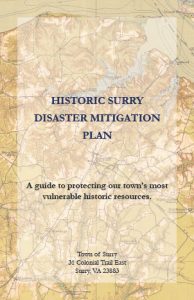Natural Disaster
Recovery Advisory for Owners and Managers of Historic Buildings

Report Damage
If your historic property has been damaged by a disaster, please use the following survey form to report the damages to VDHR. This information will assist VDHR in assessing the intensity of damage from disasters and program funding earmarked for recovery efforts.
Before filling out this survey, please visit the VCRIS Public Viewer to determine if the property has an existing DHR ID number (additional instructions can be found here).
If your property does not have an existing DHR ID number or you are unable to locate it, you may still complete this form to report damages to VDHR. If you would like to provide additional information on an unrecorded property, please reach out to DHR: VDHR’s Architectural Survey Manager, Mae Tilley (804-482-6086; mae.tilley@dhr.virginia.gov).
Find Consultants
Please Note: DHR provides the Trades & Consultants Directory (updated regularly) as a free service to property owners, local governments, and state and federal sponsors in Virginia seeking the assistance of people and professional firms with expertise in historic preservation. The directory is not an endorsement by the department or a demonstration of professional competence. As a government agency, DHR cannot recommend the services of an individual consultant and does not accept responsibility for the performance of any consultant.
The directory should not be construed as an “approved” list. Determining the suitability of the providers is the responsibility of the property owners. It is also the responsibility of the property owner to obtain all appropriate permits and to ascertain that contractors have the appropriate licenses. Licensing requirements and status may be checked at the Department of Professional and Occupational Regulations. If you are a tradesmen or expert in historic repairs or a preservation consultant and you would like to be included in the directory, please contact Megan Melinat.
Before a Storm Strikes
DHR shares the following guidance on how to prepare yourself, your family, and your historic property for an impending hurricane or storm, and what to do if your property is negatively impacted:
The checklist above may help you prioritize tasks in preparing for adverse weather. Please know that DHR staff will be ready to assist you during the recovery efforts. Reports of damage reports and requests for technical assistance for owners of historic properties can be sent to Stephanie Williams; for properties under easement with DHR, please contact Megan Melinat (tel. 804-482-6455). You can also contact DHR staff in our Regional Offices. (Regional staff is listed on the last page of the document linked above).
Also, the National Park Service’s Guidelines on Flood Adaptation for Rehabilitating Historic Buildings (2021) provides information about how to adapt historic buildings to be more resilient to flooding risk in a manner that will preserve their historic character. The treatments described in the document may be considered as means of preserving the historic properties located on floodplains and making them resilient to flooding hazards.
Helpful Links for Recovery after Flooding:
Tips and guides for actions to take after floods / hurricanes (these links go to other websites):
- Drying Out a Water Damaged Building: This video gives you a few tips for drying out historic properties if you’ve experienced any flood conditions from storms. (North Carolina Division of Cultural Resources)
- Treatment of Flood-Damaged Older and Historic Buildings (pdf from National Trust for Historic Preservation)
- Tips for Drying Out a Water-Damaged Building (North Carolina Division of Cultural Resources)
- As the Floodwaters Recede–A Checklist of Things to Do (North Carolina Division of Cultural Resources)
- After the Flood: Advice for Salvaging Family Damaged Treasures (FEMA)
- Tips For Handling Insurance Claims For Historic Properties Following A Disaster (North Carolina Division of Cultural Resources)
- Mobile App: ERS: Emergency Response and Salvage (National Center for Preservation Technology and Training). About the app (from the NCPTT website): The Emergency Response and Salvage app outlines critical stages of disaster response, such as stabilizing the environment and assessing damage. It also provides practical salvage tips for nine types of collections: photographs, books and documents, paintings, electronic records, textiles, furniture, ceramics/stone/metal, organic materials, and natural history specimens. This app will help users protect precious collections and significant records, access reliable information instantly, and save damaged objects.
- National Center for Preservation Technology and Training also has information on post-disaster recover.
Links for Addressing Moisture in Old Buildings:
- Preservation Brief 39: Holding the Line: Controlling Unwanted Moisture in Historic Buildings
(NPS/Technical Preservation Services) - Managing Moisture in Your Historic House (NPS/Technical Preservation Services)
 Historic Surry Disaster Mitigation Plan
Historic Surry Disaster Mitigation Plan
This plan provides useful guidelines for all Virginians about preparing for and recovering from a natural or man-made disaster, specifically when it comes to historic properties. The 30-page plan, created in 2016, is the result of a grant administered by DHR from the the NPS’s Historic Preservation Fund–Hurricane Sandy Disaster Relief Assistance Grant.
See these helpful checklists (excerpted from the plan) for preparation and recovery from disasters.
General Information for Property Owners:
- Virginia Department of Emergency Management (VDEM)
- Federal Emergency Management Agency (FEMA)
- Preservation Briefs and Technical Guidance (NPS/search by topic)Dam


